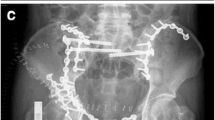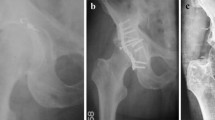Abstract
Background
Traumatic hip dislocation with fracture of the posterior acetabular wall is associated with high rates of residual invalidity.
Methods
The records of patients who underwent surgical treatment of traumatic dislocation of the hip associated with an isolated fracture of the posterior acetabular wall from 1999 to 2009 were reviewed. There were 30 men and 12 women, who at the time of the trauma had a mean age of 42 years (range 21–65). Mean follow-up duration was 5 years (range 2–10). Pre-operative fracture evaluation was based on the classification of Judet et al. which divided this fractures into three types: type 1 is characterized by a single fracture line separating a single bone fragment from the remaining part of the posterior wall; type 2 fracture involves several fragments of the posterior wall and in type 3, a type 1 or type 2 fracture is associated with a sunk cancellous area in the acetabular wall medial to the fracture line but not affected by it, due to the shear impact of the femoral head at the time of dislocation. Clinical evaluation of the outcome was according to the criteria of Merle D’Aubigné and Postel as modified by Matta. Outcomes were divided into excellent/good and fair/poor. Since treatment was standard, data were further analyzed to assess the relative importance of age, sex, follow-up duration, sciatic nerve lesion on admission and mechanism of injury, using the Chi-square test.
Results
Full clinical recovery without sequelae or radiographic abnormalities was achieved by 10 patients, 8 with type 1 fracture and 2 with type 2 fracture. A good outcome was seen in 13 patients, 3 with type 1 fracture, 9 with type 2 fracture and 1 with type 3 fracture. Eight patients, 3 with type 2 fracture and 5 with type 3 fracture, had a fair outcome. Only follow-up ≥6 years influenced outcome significantly (p > 0.005).
Conclusion
Our conclusions in light of our experience are that in type 1 lesions, anatomical reduction and stabilization achieve excellent outcomes, both clinical and radiographic; type 2 fractures pose greater prognostic problems because their outcome is determined by the success of the reduction and fixation of a multi-fragment fracture; finally, different considerations apply to type 3 fractures, which present varying degrees of comminution and an impacted acetabular surface: their outcome depends on the quality of the anatomical and morphological restoration of acetabular congruence.





Similar content being viewed by others
References
Letournel E, Judet J (1993) Fractures of the acetabulum, 2nd edn. Springer, New york
Laird A, Keating JF (2005) Acetabular fractures. A 16 year prospective epidemiological study. J Bone Joint Surg 87-B:969–973
Judet R, Judet J, Letournel E (1964) Fractures of the acetabulum: classification and surgical approaches for open reduction. J Bone Joint Surg 46-A:1615–1646
Zinghi GF (2000) Fracture of the pelvis and acetabulum. Timeo Editore s.r.l, Bologna
Merle D’Aubigné RM, Postel M (1954) Functional results of hip arthroplasty with acrylic prosthesis. J Bone Joint Surg 36:451–475
Matta JM (1996) Fractures of the acetabulum: accuracy of reduction and clinical results in patients managed operatively within 3 weeks after the injury. J Bone Joint Surg 78-A:1632–1645
Epstein HC (1974) Posterior fracture-dislocations of the hip. Long-term follow-up. J Bone Joint Surg 56-A:1103–1127
Baumgaertner MR (1999) Fractures of the posterior wall of the acetabulum. J Am Acad Orthop Surg 7:54–65
Kreder HJ, Rozen N, Borkhoff CM, Laflamme YG, McKee MD, Schemitsch EH, Stephen DJG (2006) Determinants of functional outcome after simple and complex acetabular fractures involving the posterior wall. J Bone Joint Surg 88(6):776–782
Rickman M, Bircher MD (2008) Acetabular fractures in the 21st century. Trauma 10:149–173
Gansslen A, Steinke B, Krettek C (2009) Internal fixation of acetabular posterior wall fractures. Operative Orthopadie und Traumatologie 21:283–295
Pascarella R, Maresca A, Reggiani LM, Boriani S (2009) Intra-articular fragments in acetabular fracture-dislocation. Orthopedics 32:402
Keith JE, Brashear HR, Guilford WB (1988) Stability of posterior fracture-dislocations of the hip. Quantitative assessment using computed tomography. J Bone Joint Surg 70-A:711–714
Moed BR, McMichael JC (2007) Outcomes of posterior wall fractures of the acetabulum. J Bone Joint Surg 89-A:1170–1176
Vailas JC, Hurwitz S, Wiesel SW (1989) Posterior acetabular fracture-dislocations: fragment size, joint capsule and stability. J Trauma 29:1494–1496
Olson SA, Bay BK, Pollak AN, Sharkey NA, Lee T (1996) The effect of variable size posterior wall acetabular fractures on contact characteristics of the hip joint. J Orthop Trauma 10:395–402
Moed BR, Ajibade DA, Israel H (2009) Computed tomography as a predictor of hip stability status in posterior wall fractures of the acetabulum. J Orthop Trauma 23:7–15
Giannoudis PV, Grotz MRW, Papakostidis C, Dinopoulos H (2005) Operative treatment of displaced fractures of the acetabulum. A meta-analysis. J Bone Joint Surg 87-B:2–9
Pantazopoulos T, Nicolopoulos CS, Babis GC, Theodoropoulos T (1993) Surgical treatment of acetabular posterior-wall fractures. Injury 24:319–323
Olson SA, Finkemeier CG (1999) Posterior wall fractures. Oper Tech Orthop 9:148–160
Swanson MA, Knight JR, Huo MH (2009) Total hip arthroplasty following previous acetabular fracture. Oper Tech Orthop 19:150–154
Wj Daum, Scarborough MT, Gordon W Jr, Uchida T (1992) Heterotopic ossification and other perioperative complications of acetabular fractures. J Orthop Trauma 6:427–432
Helfet DL, Schmeling GJ (1991) Management of acute displaced acetabular fractures using indirect reduction techniques and limited approach. Orthop Trans 15:833–834
Conflict of interest
The authors declare they have no conflict of interests.
Author information
Authors and Affiliations
Corresponding author
Rights and permissions
About this article
Cite this article
de Palma, L., Santucci, A., Verdenelli, A. et al. Outcome of unstable isolated fractures of the posterior acetabular wall associated with hip dislocation. Eur J Orthop Surg Traumatol 24, 341–346 (2014). https://doi.org/10.1007/s00590-013-1200-7
Received:
Accepted:
Published:
Issue Date:
DOI: https://doi.org/10.1007/s00590-013-1200-7




